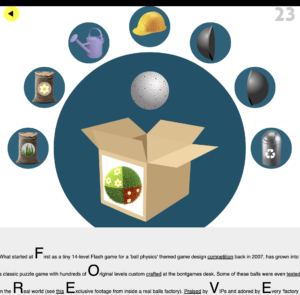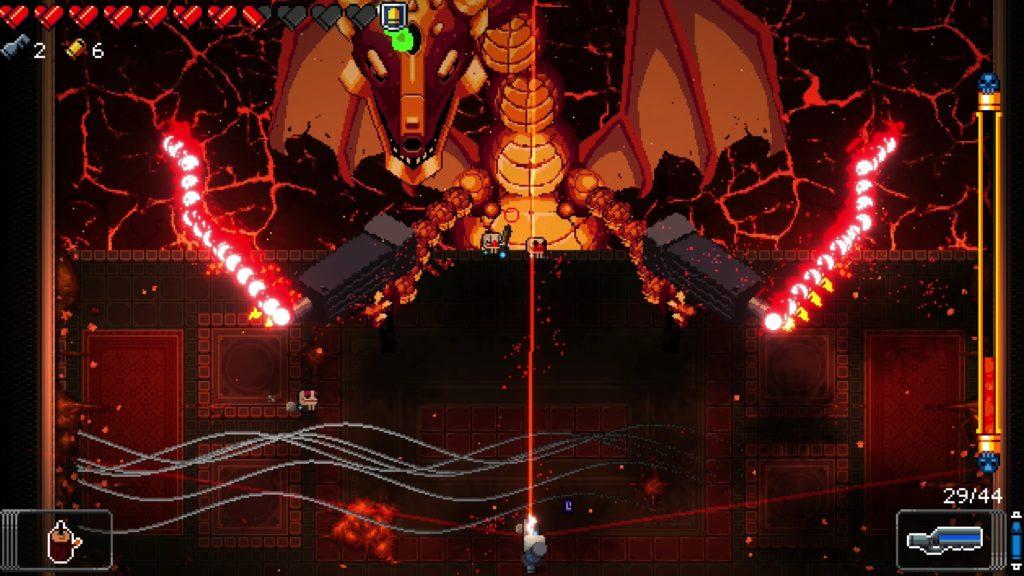 Overview
Overview
For my critical play, I decided to try out Factory Balls, a puzzle game by Bart Bonte that you can play pretty much anywhere including on your phone, computer, or just in a browser. The game is for anyone who likes logic puzzles, but it’s especially great for casual players who just want to solve problems without feeling pressured. There’s no story or characters, just a bunch of levels where you use different tools to paint and decorate a white ball so it matches a target design. The audience is very diverse and the ager raring could be considered 4+.
The setting is simple as it is set in factory where you work with paint, masks, and other gadgets. The world is clean and abstract, which makes it easy to focus on the puzzles. According to the Narrative Elements Explained handout, setting is important for grounding the player, but in Factory Balls, the world is really just a backdrop for the puzzles you’re solving. The game puts you in the driver’s seat, you’re the one making the choices and seeing the results of your actions right away, so it feels really personal and hands-on.
Experience
This was my first time playing Factory Balls, and I got hooked right away. Honestly, I think my brain really did grow through the process. At first, I was a little confused. I approached each level by looking at the finished ball and trying to figure out what the last step must have been, like, what was the final, most recent change? Once I had a guess, I’d work backward, seeing what overlapped with what and planning my moves step by step. It took a lot of trial and error, but that was part of what made it so satisfying.
Every time I got stuck, I could reset the ball and try again, which made it feel low-pressure and encouraged me to experiment. The game teaches you by doing, you learn the mechanics as you play, and the feedback is instant. If you mess up, you just start over. That made the learning curve feel smooth, and I never felt frustrated for long. The puzzles got harder as I went, but the game always introduced new tools in a way that made sense, so I could build on what I already knew.
I really liked how the game made me think in layers. For example, sometimes you have to put on a hat or goggles before painting, so that certain parts of the ball stay white or a different color. Other times, you have to use seeds and water to grow grass or flowers on the ball, which was a fun twist. Each new mechanic felt like a little puzzle inside the bigger puzzle, and I always felt a sense of accomplishment when I figured out the right order.
Mechanics & Feedback
The mechanics in Factory Balls are simple but clever. You get a set of tools for each level, including paint, hats, belts, goggles, seeds, watering cans, and more, and you have to use them in the right order to match the target design. The order matters a lot: if you paint before putting on a mask, the mask will block the paint from certain areas, but if you paint after, it will cover everything. This creates a lot of possibilities and makes each level a mini logic puzzle.
The game starts easy, with just a couple of tools, and gradually introduces new ones. This progressive difficulty is a smart design choice, it keeps the game accessible for beginners but still challenging for more experienced players. The game also gives you instant feedback: as soon as you use a tool, you see the result on the ball. If you make a mistake, you can reset and try again right away. That makes the game feel forgiving and encourages experimentation.
One of the best things about Factory Balls is how it teaches you to think in patterns and sequences. You have to recognize shapes, colors, and layers, and figure out the right order to apply the tools. This is a great example of what the Theory of Fun calls “puzzles to solve”. Games are about learning patterns and mastering new challenges, and Factory Balls does this really well. The game is also highly replayable, since you can try different orders or strategies to see what works.
That said, the game isn’t perfect. Sometimes, especially on harder levels, I wished there was an undo button for individual steps. If you make a small mistake late in the process, you have to reset the whole ball and start over, which can be a little frustrating. But overall, the mechanics are well-designed and make the game both challenging and fun.

Ethics
Factory Balls is a very abstract game—there’s no story, no characters, and no cultural references. The puzzles are all about logic, pattern recognition, and spatial reasoning. That means the game is accessible to a wide range of people, but it also makes some assumptions about what players know.
The game assumes that players are comfortable with basic logic and can think in layers and sequences. It also assumes that players can recognize shapes and colors, which could be a barrier for people with color vision deficiencies or certain cognitive differences. The game doesn’t require any language skills or cultural knowledge, which makes it inclusive in some ways, but it might exclude people who struggle with abstract thinking or visual puzzles.
According to The Psychology of World Building, world building is about more than just setting—it’s about how characters and their relationships shape the world. In Factory Balls, there are no characters or relationships, so the world is purely mechanical. This makes the game very focused on the puzzles themselves, but it also means there’s no emotional or social layer to the experience.
If I were to mod the game, I might try to add more accessibility options, like colorblind modes or hints for players who get stuck. I might also experiment with adding a simple narrative or characters, to see if that makes the world feel more engaging. But overall, Factory Balls is a great example of how mechanics can shape the player’s experience and teach new ways of thinking.



